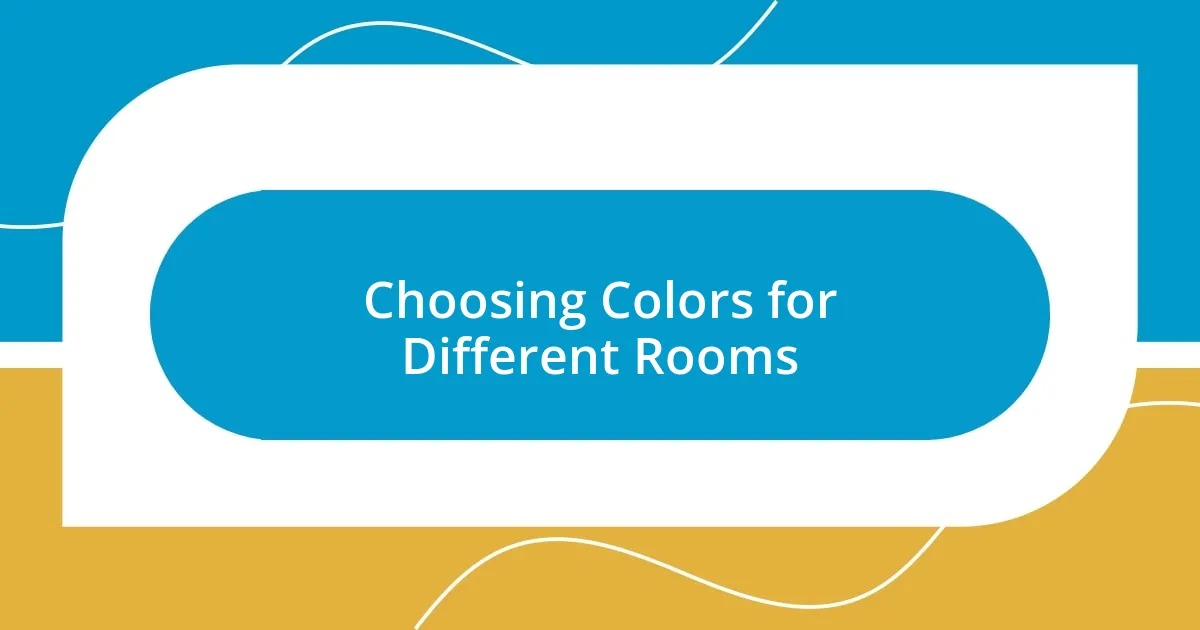Key takeaways:
- Color psychology reveals how different colors can evoke specific emotions, influencing mood and behavior in various spaces.
- Choosing colors for rooms should align with their purpose, such as calming blues for bedrooms and energizing yellows for kitchens.
- Combining colors can enhance mood; for example, pairing blue and orange in a workspace encourages creativity and productivity.
- Practical application involves testing paint samples, considering accent colors, and balancing size and scale to create desired emotional effects.

Understanding Color Psychology
Color psychology delves into how different hues can evoke specific feelings and behaviors. For instance, when I paint a room in calming blues, I notice an immediate sense of tranquility washing over me. Have you ever felt more relaxed in a space that uses softer tones? It’s fascinating how colors can create an atmosphere that envelops us emotionally.
I often find myself attracted to vibrant reds when I want to invigorate my energy. This bold color has a way of sparking excitement and passion, both in my surroundings and within myself. Interestingly, I’ve seen how red accents in art can grab attention, making a powerful statement—almost like saying, “Look here!” It’s amazing how colors can shout or whisper, guiding our mood in subtle, yet profound ways.
Green is another color that resonates deeply with me, especially in moments of stress. It brings thoughts of nature and renewal. When I step outside into lush greenery, I can almost feel the tension melt away. Have you noticed how a simple walk in the park can shift your mindset? This connection to green reminds us of balance and harmony, making it a powerful ally in our emotional toolkit.

Impact of Color on Emotions
Color has a profound ability to shape our emotional landscape. One time, I painted a small nook in my home a soft lavender—it’s surprising how much calmer I felt when I curled up with a book there. I often hear others share similar experiences: a cozy room painted in gentle pastels can almost cradle you in comfort, while a bold, dark color might elicit feelings of heaviness or melancholy.
Here’s a quick breakdown of some common colors and their emotional impact:
- Blue: Often associated with calmness and tranquility. Think of the serene sky on a clear day.
- Red: Infused with energy and passion. It can evoke excitement, but too much may feel overwhelming.
- Yellow: Radiates cheerfulness and optimism, like a bright sunflower turning toward the sun.
- Green: Represents growth and renewal, reminiscent of lush forests and fresh beginnings.
- Orange: Carries warmth and enthusiasm, often inspiring creativity and social interactions.
I remember rearranging my workspace with a splash of orange accents; it instantly lifted my spirits and encouraged me to tackle my to-do list with more enthusiasm. Isn’t it amazing how a simple change can shift our emotional energy?

Choosing Colors for Different Rooms
When it comes to choosing colors for different rooms, I’ve learned that each space can benefit from a unique hue that aligns with its purpose. For instance, I prefer a tranquil blue in my bedroom because it creates a soothing sanctuary for rest. In contrast, I often use energizing yellow in my kitchen; it’s remarkable how this bright color can invigorate my mornings and inspire creativity when I’m whipping up breakfast.
The living room serves as a gathering place, so I usually opt for warm neutrals or soft earth tones. I find that these colors encourage conversation and make guests feel at home. A friend of mine once painted her living room in a rich terracotta, and the atmosphere transformed into a cozy retreat where laughter and storytelling flourished. It’s fascinating how a color can instantly shift the dynamics of a space.
I also believe that lighter colors can enhance smaller rooms. For instance, I painted my tiny bathroom in a soft mint green, which not only made the space feel larger but also gave it a refreshing vibe. It’s incredible how a strategic color choice can open up possibilities and even improve our mood in those everyday spaces.
| Room | Recommended Color | Emotional Impact |
|---|---|---|
| Bedroom | Calming Blue | Promotes relaxation and restfulness |
| Kitchen | Energizing Yellow | Boosts creativity and energy |
| Living Room | Warm Neutral | Encourages conversation and warmth |
| Bathroom | Soft Mint Green | Creates a refreshing and spacious feel |

Color Combinations for Mood Enhancement
Combining colors can create a significant shift in mood, and I’ve personally experimented with various pairings. One memorable combination for me was blue and orange in my home office. The calming influence of blue balanced by the energizing effect of orange not only made my workspace feel vibrant but also sparked creativity each time I sat down to work. Have you ever noticed how certain combinations can strike the right emotional chord?
In my living room, I decided to pair soft greens with warm browns. This blend cultivates a serene yet earthy atmosphere, perfect for unwinding after a long day. The natural elements make me feel grounded and connected, as though I’ve brought a piece of the outdoors inside. It makes me wonder—can color combinations we choose truly reflect the environment we wish to create around us?
I’ve found that adding splashes of contrasting colors can boost the overall effect, too. Last summer, I opted for a bold pop of yellow through cushions against a slate gray sofa. The excitement of yellow effortlessly brightened the room, uplifting my mood during those dreary rainy days. It’s fascinating how something as simple as color juxtaposition can generate such an emotional response, don’t you think?

Practical Tips for Color Application
When applying color in your space, I highly recommend testing out paint samples before committing. A few years ago, I painted a section of my hallway a vibrant coral, which initially seemed fantastic. However, once it dried, I realized it clashed with my decor, and I had to repaint. I’ve learned that seeing colors in different lighting throughout the day can dramatically change their appearance, so take the time to live with those samples for a while.
I’ve also discovered the power of accent colors. In my dining area, I incorporated a deep navy blue on one wall, which beautifully highlights my collection of warm wood accents. It not only frames the room but also creates a cozy ambiance, perfect for intimate dinners. Have you ever thought about how a single accent wall can elevate a whole room’s vibe?
Lastly, consider the scale and size of the colors you’re using. Large, bold colors might overwhelm a small space, while delicate pastels can get lost in a larger room. When I chose a rich emerald green for my home office, it surprisingly wrapped the space in warmth without making it feel cramped. Personally, this balancing act between size and color is essential for crafting a desired mood—what colors work best for you in your spaces?

Case Studies of Color Influence
In a fascinating study, researchers found that participants exposed to red in a dining environment reported increased appetite and heightened energy. I once experimented with this in my kitchen by adding red accents—like a rug and some vibrant dishware. The result was surprising. It not only made meal preparation feel more exciting but also transformed family dinners into lively, engaging experiences. Have you ever thought about how the colors in your dining space can change the entire atmosphere?
Another intriguing case involved a workspace painted in pale yellow. An office in a corporate building experienced noticeable increases in productivity and morale after a simple color refresh. I’ve seen this firsthand when I painted my previous office a light shade of yellow. It created a warm, inviting environment that encouraged collaboration among colleagues. Does the color of your work environment affect your motivation as much as it does mine?
There’s also the example of a local wellness center that opted for tranquil blues and greens throughout its treatment rooms. Clients reported feeling calmer and more at ease during their sessions. I could relate to this, as using soft blue in my bedroom has created a peaceful retreat after busy days. It makes me wonder: could the colors in our spaces be the unsung heroes of emotional well-being?














